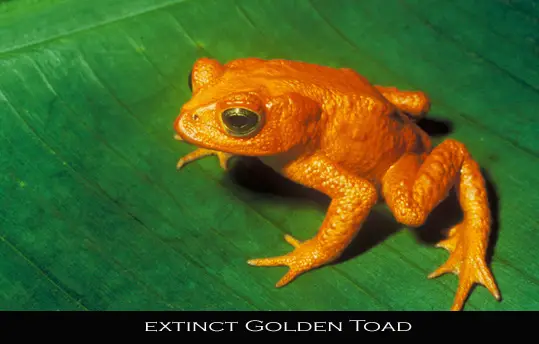The extinct Golden Toad (Bufo periglenes) was a small, shiny, bright-orange toad that was once abundant in a small region of high-altitude cloud-covered tropical forests, about 30 square kilometers in area, above the city of Monteverde, Costa Rica. For this reason, it is sometimes also called the Monteverde Golden Toad, or the Monte Verde Toad.
The Golden Toad was described in 1966 by the herpetologist Jay Savage. Since 1989, not a single Golden Toad has been seen anywhere in the world, and it is classified by the IUCN as an extinct species.
Frogs or amphibians are extremely sensitive indicators of environmental changes, as the uptake of oxygen and water through their skin can increase concentrations of pollutants, and the life cycle of frogs and toads exposes them to water and airborne contaminants. Amphibians are so sensitive to changes in the environment that scientists have likened them to a canary in a coalmine.

It is known that droughts have large impacts on many of the forests of Central America, and the timing and severity of drought is often the strongest climatic influence on the ecology of tropical moist forests. Mike Hulme and Nicola Sheard of the Climatic Research Unit at the University of East Anglia say that “climate change may already be altering the ecology of the Monteverde cloud forest in Costa Rica. This tropical forest environment, reaching up to 1500m above sea-level, relies on low-hanging clouds for delivering much of the moisture the forest needs during the January-April dry season. An increasing number of ‘dry days’ since the 1970s has reduced the mist frequency in this montane forest, a trend which has been compounded by increased temperatures, especially during night-hours. These climate changes have restricted the habitat for many of the 50 montane frog species that used to inhabit this forest.
The Monteverde cloud forest provided the only known habitat for the extinct golden toad which, along with the harlequin frog and 20 other amphibious species, became extinct around 1986-87. This coincided with a major El Niñoevent when climatic conditions in Costa Rica were particularly warm and dry.”
Mike and Nicola maintain that “future climate change is likely to exacerbate this situation with more frequent dry winters and warmer temperatures. By the 2050s, ‘dry’ winters will become up to twice as frequent and ‘warm’ winters will occur in between 50 and 100 per cent of years. This is likely to lead to many more periods during future winter dry seasons when clouds will be less prevalent over the mountain forests, thus seriously damaging this unique mountain habitat for amphibians and cloud-forest lizard species.”
Many species that are unable to adapt to the changes human are inflicting on the Earth, and are facing extinction. In fact, predictions estimate that up to 1 million species may become extinct as a result of climate change. The extinct Golden Toad and rapid demise of the Harlequin Frog are examples of how humans are significantly reducing Earth’s biodiversity.
References: Hulme,M. and Sheard,N. (1999) Climate Change Scenarios for Mesoamerica Climatic Research Unit, Norwich, UK, 6pp.
Britton, H. (2005) The Extinction of the Golden Toad FINAL, Symptom of a Worldwide Crisis, http://jrscience.wcp.muohio.edu/fieldcourses05/ PapersCostaRicaArticles/TheExtinctionoftheGoldenT.html
|
Other Species Impacted Upon by Climate Change
Quiver Tree |
